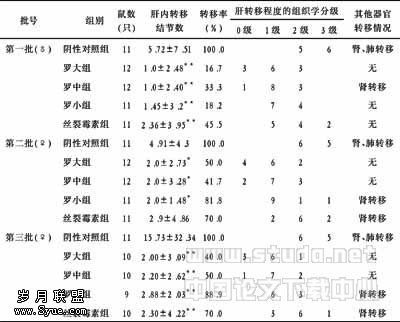Smac基因调控肿瘤化疗敏感性的研究进展
【摘要】 细胞凋亡异常是肿瘤细胞产生耐药性的关键因素之一。Smac是近年新发现的一种由线粒体释放的促凋亡蛋白,参与细胞凋亡的线粒体通路和死亡受体通路的下游反应,通过特异性地结合凋亡抑制蛋白IAPs,解除后者对caspase 的抑制而促进凋亡。肿瘤组织中Smac存在不同程度的缺失和释放障碍,利用基因转导手段将Smac基因导入胃癌细胞,提高常用的对胃癌敏感化疗药物对胃癌细胞株的诱导调亡作用,具有广泛的应用前景和现实的临床指导意义。
【关键词】 基因 Smac 化学疗法 肿瘤
Smac (second mitochondrial activator of caspase)也被称为DIABLO(direct IAP binding protein with low PI,低等电点的IAP直接结合蛋白)[1],是2000年发现的一种存在于线粒体并且调节细胞凋亡的蛋白质,主要通过抑制凋亡抑制蛋白(inhibitor of apoptosis proteins,IAPs)的活性而发挥促凋亡作用。本文就Smac的结构、促进凋亡的机制及其在肿瘤化疗中的影响作一综述。
1 Smac基因概述
人类Smac/DIABLO基因位于第12条染色体的长臂,由7个外显子组成,体内至少存在Smac-α,Smac-β,Smac-γ,Smac-δ等几种剪接变异体。Smac在胞浆中合成时由239个氨基酸前体组成,其氨基末端最初的55个氨基酸残基为线粒体靶序列(mitochondrial targeting sequence, MTS),转运到线粒体后MTS被裂解,最终生成含有184个氨基酸残基的成熟蛋白,以二聚体的形式存在于线粒体的膜间隙,只有在诱导凋亡因子的作用下才会释放进入细胞质。
2 Smac与肿瘤的关系
2.1 Smac在肿瘤中的表达 Smac与肿瘤的关系非常密切,研究发现,地塞米松与2-甲氧雌二醇都能通过促进Smac的释放诱导多发性骨髓(MM)细胞的凋亡,而且2-甲氧雌二醇的作用不受Bcl-2 的抑制[2]。另外,Kim等[3]用免疫组化分析了Smac的表达,结果显示癌瘤中表达率为62%,肉瘤中表达率为22%,8例血管肉瘤和8例脂肉瘤中无表达。表明Smac在不同癌组织中表达不同,提示低表达Smac可能抑制凋亡。Sekimura等[4]检测了88例肺癌组织样本中Smac mRNA的表达,发现肺癌组织中Smac mRNA的表达明显低于正常肺组织,其中T2~T4期肺癌组织中的表达又低于T1期,Smac mRNA低表达的病人预后差。Smac能作用于细胞凋亡的不同阶段,在凋亡信号存在下有明显的增强凋亡效应,显示了在诱导肿瘤细胞凋亡中的应用前景。
2.2 Smac在促凋亡中的主要作用 凋亡抑制蛋白(inhibitor of apopto proteins,IAPs)是细胞中的一类大的蛋白家族,在功能上抑制胱氨酸酶的活性,但这种抑制作用可被其他因素减弱或去除,其中从线粒体释放的Smac就是一类可以减弱IAPs功能的蛋白质[5]。 Smac主要通过与IAPs竞争结合caspase而抑制IAPs的功能,IAPs家族的普遍特征是含有BIR结构域,BIR是IAPs家族和caspase结合的结构基础,同时也是和Smac结合的结构基础。Smac N端含有的一段保守序列Ala-Val-Pro-Ile(AVPI),与BIR结构结合抑制IAP的功能[1]。Smac可通过两种途径促进凋亡,即水解caspase-3的蛋白和增强成熟caspase -3的酶催化活性[6,7],这两功能都有赖于Smac与IAPs的相互作用[8]。最近发现一种含有BIR结构域的蛋白Apollon可以和Smac结合而阻断Smac诱导的细胞凋亡[9]。表明保守序列AVPI和IAPs结构域BIR的结合在Smac发挥促凋亡过程中有着重要作用。
Merrison[10]等发现Smac的C末端也有促进凋亡的功能。此外Smac还具有其他机制来调节IAP,研究发现[11],Smac可以增强IAP泛素连接酶活性而降解IAP蛋白的含量,从而提高Smac的相对浓度,促进细胞凋亡。另外还发现Smac可以借助其他分子的作用而不会自身泛素化,这有利于其功能的发挥。
3 Smac与化疗的关系
肿瘤细胞对化疗抵抗正成为影响肿瘤患者效果的一个主要方面。多数学者认为,抗肿瘤药物的疗效主要取决于其激活细胞凋亡的能力[12]。IAPs作为哺乳动物细胞的一类内源凋亡抑制物,是目前最受重视的细胞凋亡调控因子家族。
IAPs家族成员广泛存在于肿瘤细胞,也为Smac提供了作用靶点。较多的研究表明在肿瘤细胞中还存在着Smac释放障碍。许多肿瘤细胞中XIAP呈过表达,这也抑制了线粒体释放Smac[13]。实验证实 ,Smac并不诱导健康细胞凋亡,其功能的发挥有赖于胞内定位的改变(由线粒体释放到细胞浆)[14],但是含有过量Smac的细胞对凋亡促进药物的敏感性大大增加,而耐药性大大降低。因此有效运用调节胞浆Smac含量的手段有利于提高抗肿瘤治疗的效果。
DU Jihui[15]等在胰腺癌的化疗中发现,线粒体释放Smac下调XIAP是胰腺癌化疗的重要决定因素,而上调Smac活性蛋白的表达可通过拮抗XIAPA的凋亡抑制作用协同化疗药物促进癌细胞死亡。
化疗和γ射线治疗肿瘤依赖于诱导细胞凋亡, 然而只有很少的肿瘤是对这些治疗完全敏感,肿瘤细胞对这些治疗抵抗是因为凋亡程序激活的失败。调整在凋亡信号中的关键因素可以直接影响诱导治疗肿瘤细胞死亡效果。Fulda[16]等报道转染Smac基因能增强化疗药物的诱导凋亡作用,通过颅内恶性胶质瘤模型,发现Smac能显著增强Apo-2L/TRAIL的体内抗肿瘤作用。现在认为Smac氨基酸的肽模仿物可能是一种新的有效治疗肿瘤的手段[17]。
4 Smac在胃癌化疗中的作用
郑丽端[18]等采用脂质体将Smac基因转染入胃癌细胞株MKN-45,G418 筛选获得抗性亚克隆细胞株,建立分别稳定表达Smac基因、新霉素抗性基因(neo)的胃癌亚克隆细胞株MKN-45/Smac、MKN-45/neo。利用RT-PCR和Western Blot证实MKN-45/Smac细胞的Smac mRNA及蛋白表达水平均显著高于MKN-45、MKN-45/neo(P<0. 01)。10μg/ml MMC作用24h后,MKN-45、MKN-45/neo细胞生长抑制率分别为(15.2±0.8)%、(16.5±1.1)%,而MKN-45/ Smac则高达(36.4±2.1)%(P<0. 01);同MKN-45、MKN-45/neo细胞株比较,MKN-45/Smac的克隆形成能力降低了。稳定转染Smac基因使其在胃癌细胞株中过表达,能显著提高癌细胞对MMC的敏感性,说明其在胃癌化疗中的利用价值。
常见药物对Smac化疗的影响
(1)姜黄素
国内外的许多研究表明姜黄素对多种体外培养的肿瘤细胞有生长抑制作用[19],可以增强化疗的疗效,Surajit Karmakar[20]在建立的人恶性胶质瘤T98G细胞中发现姜黄素能够增加线粒体对Smac的释放,caspase-9和caspase-3分别在T98G细胞35KD和20KD的子代活性片段中检测到,表明姜黄素能够通过受体介导和线粒体介导的蛋白水解机制促进T98G细胞的凋亡。郑丽端[21]等发现姜黄素作用胃癌细胞株MKN245,能抑制其生长并诱导细胞凋亡。
(2)丝裂霉素(MMC)
MMC在化疗中应用广泛,其对细胞G0期的抑制很明显[22],郑丽端[18]等观察了MMC在不同浓度下对胃癌细胞生长的抑制作用,发现MKN-45,MKN-45/neo 和MKN-45/Smac的细胞活性降低呈时间和剂量依赖性。利用机(重建)影像系统分析指出p20在MKN-45/Smac的表达显著高于MKN-45和MKN-45/neo,p20的表达水平在MKN-45和MKN-45/neo中差异无统计学意义。可以看出,在联合MMC和Smac,可以显著提高胃癌细胞对化疗的敏感性。
综上所述,Smac在肿瘤的发生,以及化疗的过程中有着重要的作用,随着对Smac的深入研究,一些其他关键性的问题如过量Smac是否有害,Smac在不同肿瘤化疗中的效果,及其毒性等被阐明,Smac将在肿瘤治疗方面有一个广阔的应用前景。
【】
[1] Du C, Fang M, Li Y, et al. Smac, a mitochondrial Protein that Promotes Cytochrome c-Dependent Caspase Activations by Elimi-nating IAP Inhibition[J]. Cell, 2000,102(1):33-42.
[2] Sun H, Nikolovska-Coleska Z, Yang CY, et al. Structure-based design, synthesis, and evaluation of conformationally constrained mimetics of the second mitochondrial-derived activator of caspase that target the X-linked inhibitor of apoptosis protein/caspase-9 interaction site[J]. Med Chem, 2004,47(17):4147-4150.
[3] Yoo NJ, Kim HS, Kim SY, et al. Immunohistochemical Analysis of Smac/DIABLO Expression in Human Carcinomas and Sarcomas[J].APMIS, 2003,111(3):382-388.
[4] Sekimura A, Konishi A, Mizuno K, et al. Expression of Smac/DIABLO is a novel prognostic marker in lung cancer[J]. Oncol Rep, 2004,11(4):797-802.
[5] Shiozaki EN, Shi Y. Caspases, IAPs and Smac/DIABLO: mechanisms from structural biology[J].Trends Biochem Sci, 2004,29(9):486-494.
[6] Chai J, Du C, Wu J, et al. Structural and biochemical basis of apoptotic activation by Smac/DIABLO[J]. Nature, 2000,406(6798):855-862.
[7] Wu G, Chai J, Suber TL, et al. Structural basis of IAP recognition by Smac/DIABLO[J].Nature, 2000,408(6815):1008-1012.
[8] Verhagen AM, Vaux DL. Cell death regulation by the mammalian IAP antagonist Diablo/Smac[J]. apoptosis, 2002,7:163-166.
[9] Hao Y, Sekine K, Kawabata A, et al. Apollon ubiquitinates Smac and caspase-9, and has an essential cytoprotection function[J].Nat Cell Biol, 2004,6(9):849-860.
[10] Darren L, Wendy Merrison, Marion MacFarlane, et al. The inhibitor of apoptosis protein-binding domain of Smac is not essential for its proapoptotic activity[J]. Cell boil, 2001,153:221-228.
[11] Creagh EM, Murphy BM, Duriez PJ, et al. Smac/Diablo antagonizes ubiquitin ligase activity of inhibitor of apoptosis proteins[J]. J Biol Chem, 2004,279(26):26906-26914.
[12] Schmitt CA. Senescence, apoptosis and therapy-cutting the life-lines of cancer[J].Nat Rev Cancer, 2003,3(4):286-295.
[13] Pardo OE, Lesay A, Arcaro A, et al. Fibroblast growth factor 2-mediated translational control of IAPs blocks mitochondrial release of Smac/DIABLO and apoptosis in small cell lung cancer cells[J].Mol Cell Biol, 2003,23(21):7600-7610.
[14] Hunter AM, Kottachchi D, Lewis J, et al. A novel ubiquitin fusion system bypasses the mitochondria and generates biologically active Smac/DIABLO[J]. J Biol Chem, 2003,278(9):7494-7499.
[15] Du Jihui, ZHANG Houde, et al. Regulatory Effects of X-linked Inhibitor of Apoptosis Protein and Pro-apoptotic Protein Smac on Apoptosis Resistance to Chemotherapy in Pancreatic Cancer Cells[J]. The Chinese-German Journal of Clinical Oncology, 2006,5(1):31-35.
[16] Fulda S, Wick W, Weller M, et al. Smac agonists sensitize for Apo-2L/TRAIL or anticancer drug-induced apoptosis and induce regression of malignant glioma in vivo[J]. Nat Med, 2002,8(8):808-815.
[17] Arnt CR, Chiorean MV, Heldebrant MP, et al. Synthetic Smac/DIABLO peptides enhance the effects of chemotherapeutic agents by binding XIAP and cIAP1 in situ[J]. J Biol Chem 2002,277:44236-44243.
[18] Li-Duan Zheng, Qiang-Song Tong, Lian Wang, et al. Stable transfection of extrinsic Smac gene enhances apoptosis-inducing effects of chemotherapeutic drugs on gastric cancer cells[J].World J Gastroenterol, 2005,11(1):79-83.
[19] Thatte U , Bagadey S , Dahanukar S. Modulation of programmed cell death by medicinal plants[J]. Cell Mol Biol( Noisy2le2grand), 2000,46(1):199 - 214.
[20] Surajit Karmakara, Naren L. Banika, Sunil J. Patel, et al. Curcumin activated both receptor-mediated and mitochondria-mediated proteolytic pathways for apoptosis in human glioblastoma T98G cells[J].Neuroscience letters, 2006,407(1):53-58.
[21] Zheng LD, Tong QS, Wu CB. Effects of Curcumin on IAPs and Smac Gene Expression of Gastric Cancer Cell Line[J]. Acta Med Univ Sci Technol Huazhong, 2005,34(2):167-170,174.
[22] Burgues JP, Gomez L, Pontones JL, et al. A Chemosensitivity Test for Superficial Bladder Cancer Based on Three-Dimensional Culture of Tumour Spheroids[J]. Eur Urol, 2007,51(x):962-969











